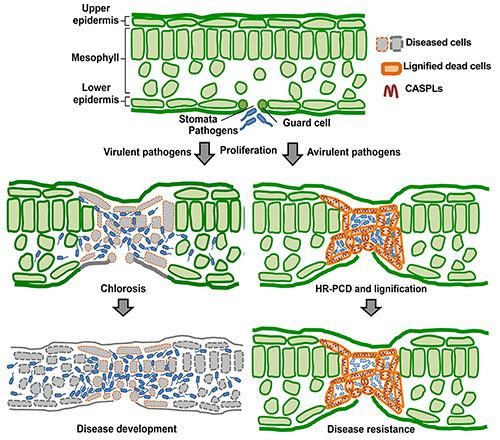Our official English website, www.x-mol.net, welcomes your
feedback! (Note: you will need to create a separate account there.)
Lignin-based barrier restricts pathogens to the infection site and confers resistance in plants.
The EMBO Journal ( IF 9.4 ) Pub Date : 2019-09-26 , DOI: 10.15252/embj.2019101948 Myoung-Hoon Lee 1 , Hwi Seong Jeon 1 , Seu Ha Kim 1 , Joo Hee Chung 2 , Daniele Roppolo 3 , Hye-Jung Lee 1 , Hong Joo Cho 1 , Yuki Tobimatsu 4 , John Ralph 5 , Ohkmae K Park 1
The EMBO Journal ( IF 9.4 ) Pub Date : 2019-09-26 , DOI: 10.15252/embj.2019101948 Myoung-Hoon Lee 1 , Hwi Seong Jeon 1 , Seu Ha Kim 1 , Joo Hee Chung 2 , Daniele Roppolo 3 , Hye-Jung Lee 1 , Hong Joo Cho 1 , Yuki Tobimatsu 4 , John Ralph 5 , Ohkmae K Park 1
Affiliation

|
Pathogenic bacteria invade plant tissues and proliferate in the extracellular space. Plants have evolved the immune system to recognize and limit the growth of pathogens. Despite substantial progress in the study of plant immunity, the mechanism by which plants limit pathogen growth remains unclear. Here, we show that lignin accumulates in Arabidopsis leaves in response to incompatible interactions with bacterial pathogens in a manner dependent on Casparian strip membrane domain protein (CASP)-like proteins (CASPLs). CASPs are known to be the organizers of the lignin-based Casparian strip, which functions as a diffusion barrier in roots. The spread of invading avirulent pathogens is prevented by spatial restriction, which is disturbed by defects in lignin deposition. Moreover, the motility of pathogenic bacteria is negatively affected by lignin accumulation. These results suggest that the lignin-deposited structure functions as a physical barrier similar to the Casparian strip, trapping pathogens and thereby terminating their growth.
中文翻译:

基于木质素的屏障将病原体限制在感染部位并赋予植物抵抗力。
病原菌侵入植物组织并在细胞外间隙增殖。植物已经进化出免疫系统来识别和限制病原体的生长。尽管植物免疫研究取得了实质性进展,但植物限制病原体生长的机制仍不清楚。在这里,我们表明,木质素在拟南芥叶子中积累,以响应与细菌病原体的不相容相互作用,其方式依赖于凯氏带膜结构域蛋白(CASP)样蛋白(CASPL)。众所周知,CASP 是木质素凯氏带的组织者,其功能是根部的扩散屏障。空间限制可以防止入侵的无毒病原体的传播,而空间限制又受到木质素沉积缺陷的干扰。此外,木质素积累会对病原菌的运动产生负面影响。这些结果表明,木质素沉积结构起到类似于凯斯帕带的物理屏障的作用,捕获病原体,从而终止其生长。
更新日期:2019-12-03
中文翻译:

基于木质素的屏障将病原体限制在感染部位并赋予植物抵抗力。
病原菌侵入植物组织并在细胞外间隙增殖。植物已经进化出免疫系统来识别和限制病原体的生长。尽管植物免疫研究取得了实质性进展,但植物限制病原体生长的机制仍不清楚。在这里,我们表明,木质素在拟南芥叶子中积累,以响应与细菌病原体的不相容相互作用,其方式依赖于凯氏带膜结构域蛋白(CASP)样蛋白(CASPL)。众所周知,CASP 是木质素凯氏带的组织者,其功能是根部的扩散屏障。空间限制可以防止入侵的无毒病原体的传播,而空间限制又受到木质素沉积缺陷的干扰。此外,木质素积累会对病原菌的运动产生负面影响。这些结果表明,木质素沉积结构起到类似于凯斯帕带的物理屏障的作用,捕获病原体,从而终止其生长。


















































 京公网安备 11010802027423号
京公网安备 11010802027423号